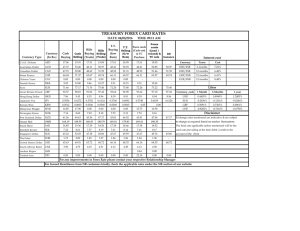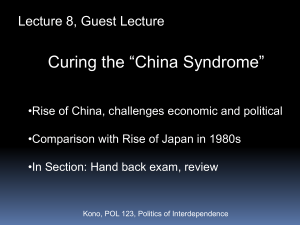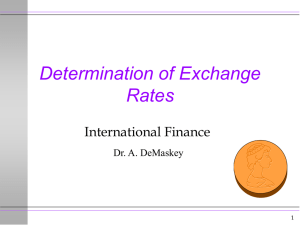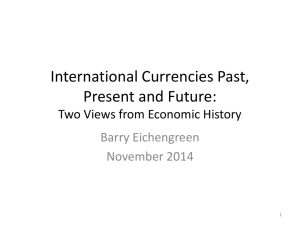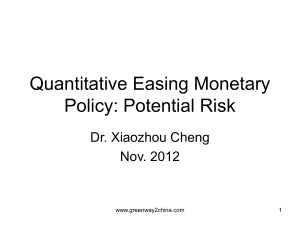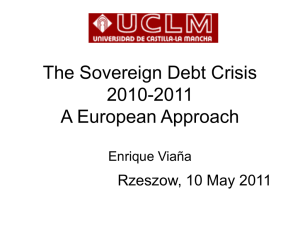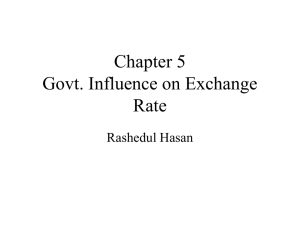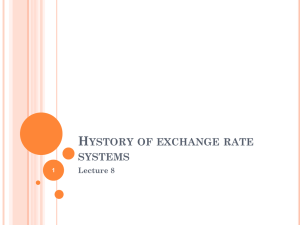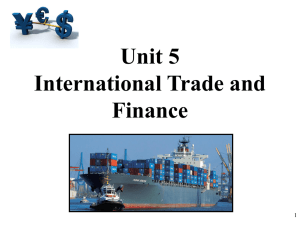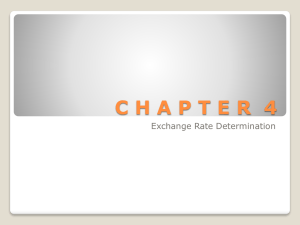Dollar vs Gold - WordPress.com
advertisement
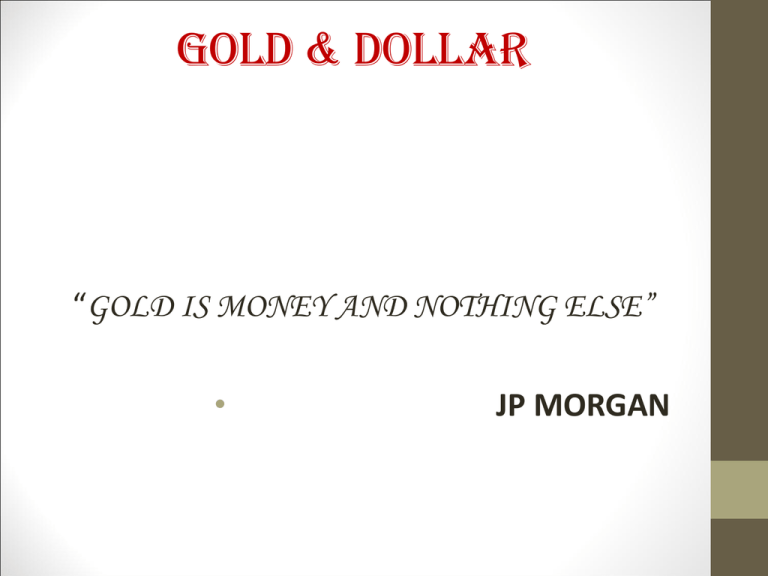
GOLD & DOLLAR “GOLD IS MONEY AND NOTHING ELSE” • JP MORGAN GOLD AS AN INVESTMENT • Most popular investment • Brought as a hedge • Subjected to speculation • Behaves like a currency GOLD AND DOLLAR RELATIONSHIP • One has to remember that gold almost never changes in value. It is the dollar that revalues in relationship to gold. • US$ gold price and the Dollar Index generally trend in opposite directions. This reciprocal relationship between gold and the dollar evident during longer period. • As a result, when the dollar weakens on the foreign exchange market over an extended period then the US$ gold price will generally rise during the same period; and when the dollar strengthens over many months the US$ gold price will usually fall. GOLD STANDARD • Gold Standard was the first universally implemented exchange system • The gold standard was mainly used from 1875 to 1914 and also during the interwar years • The government can only print as much money as its country has in gold ADVANTAGES OF GOLD STANDARD • Gives real value to currency instead of the imaginary value of currency today • The government can only print as much money as they have gold in their vaults • The gold standard places all nations on equal footing • The size and health of a country's economy is dependent upon its supply of gold. Current Gold Status • 165000 tonnes of gold mined as of 2009 • Value of $8.8 trillion • On Aug 23, 2011, gold hit a new all-time high of $1886.50 • Most of the gold ever mined is still there in some form or the other Fall of Gold Standard WW 1 and The Great Depression High Expenditure Money Supply Increased Devaluation of $ Hyperinflation Stock Market Crash Increased Trading Of Currency/ Goods Rise in Gold Price People Trade Currency For Gold Rise Of Interest Rates Bank Fails, Unemployment Rises The Bretton Woods System • World currencies tied to the dollar (Fixed exchange Rates) • Gold at $35 per ounce • Value of the dollar increased • It led to inflation and a large balance of payment deficit in the U.S • The U.S. started to deflate the dollar in terms of its value in gold. • In 1971, gold was repriced to $38 per ounce, then again to $42 per ounce in 1973. • People sold money for gold. • In 1973, the U.S. government decoupled the value of the dollar from gold altogether. • The price of gold quickly shot up to $120 per ounce in the free market. • By 1973, the United States and other nations agreed to allow exchange rates to float. Price of Gold • Price of gold is driven by supply and demand as well as speculation • Mined Gold exists in accessible form, such as bullion and mass-produced jewellery • Central banks and the International Monetary Fund play an important role in the gold price • At the end of 2004, central banks and official organizations held 19 percent of all above-ground gold as official gold reserves • Reserves as insurance against their clients' money • During any global crisis, demand for gold increases, raising gold prices. Why Invest in Gold? HEDGE AGAINST INFLATION GOLD PORTFOLIO DIVERSIFIER GOLD – STORE OF VALUE GOLD AS A SAFE HAVEN GOLD SUPPLY AND DEMAND Invest Vehicles • Traditional way is buying bullion gold bars. banks and dealers sell bullions in various size and shapes • Exchange-traded products (ETPs), ETFs, ETNs, and CEFs are traded like shares on the major stock exchanges. • Gold certificates allow investors to avoid risks associated with transfer and storage of physical bullion Break-up of Gold Holdings Jewellery 52% Central Banks Unaccounted 2% 16% Industrial Investment (bars, coins) 12% 16% What is reserve currency International pricing currency for products on global market Companies seek foreign exchange to pay for goods or services To influence their domestic exchange rate Currency held as a part of forex reserves To pay off international debt obligations Minimizes exchange rate risk Central banks hold dollars as reserve to guarantee against currency crises Salient Features of FOREX Market • Worldwide decentralized financial market for trading currencies • 36.7% of foreign exchange are traded in UK; USA accounted for 18% and Japan accounted for 6.2% • Most liquid financial market in the world • Forex market is open 24 hours a day 5 days a week • Traders include large banks, central banks, institutional investors, currency speculators, corporations, governments, other financial institutions, and retail investors • About 70% to 90% of the foreign exchange transactions are speculative • More than 60% of the world’s reserve currency is held in U.S. Dollars • Daily turnover was around $4 trillion in April 2010 • four major currency pairs that are mostly traded; the EUR/USD, USD/JPY, GBP/USD, and USD/CHF. Foreign Exchange Reserves in India FDI/FII Gold SDRs FCA Foreign Exchange Reserves • External aid Preeconomic • Commercial reforms Borrowings Era • NRI deposits Posteconomic reforms era • US Dollar • Pound Sterling • EURO • Japanese yen Is Dollar the only Powerful currency? • The euro (EUR): • far the newest currency traded among the major pairs traded on Forex markets • used by 16 European Union member countries • the strongest economies using the new common currency, such as: France, Italy and mainly Germany • The pound sterling (GBP) • a powerful and globally dynamic economy • The London commodity market plays a fundamental role in the GBP trends, being a reference for oil and gold trading • The Japanese yen (JPY) • strongest and by far the most traded currency in the Asian market. • economic situation of its main commercial partner, the USA, tends to have a direct influence on the JPY market • JPY is a low-yield currency, being the GBP/JPY the most volatile pair traded on Forex • The Swiss franc (CHF) • Though Switzerland is a small country, its strong international trade and money influx made CHF one of the main currencies traded on Forex • CHF is often preferred by low yield investors • In times of financial instability, many traders choose the CHF as a safe investment and its trends can be often compared to those of the gold • The Canadian Dollar (CAD) • Most of the Canadian production is exported to the USA • As of 2007, the Canadian dollar is the 7th most traded currency in the world and 6th in value terms • The Canadian dollar is considered to be a benchmark currency Large Gold Reserves of the World Rank Country Gold (Tonnes) % of Forex reserves 1 USA 8,133.5 74.7% 2 Germany 3,401.0 71.7% 3 IMF 2,846.7 4 Italy 2,451.8 71.4% 5 France 2,435.4 66.1% 6 China 1,054.1 1.7% 7 Switzerland 1,040.1 16.4% 8 Qatar 950.3 7.1% 9 Russia 775.2 6.7% 10 Japan 765.2 3.0% 11 Netherlands 615.5 59.4% 12 India 614.8 8.1% Dollar Debt Paradox • US tried to exert more global influence via debt, US Treasury debt • Increase demand for dollars • Soon, its trade partners held so many dollars that they feared to create a dollar crisis • US tried to lock rest of the world into dependence on a US money system • Oil shocks - dollars to import oil became national security policy for most countries • Countries tried to earn an interest rate by buying safe, secure US Treasury bonds • The biggest dollar surplus country today is China • US is being flooded with cheap Chinese goods • Top5 countries with which US has trade deficit: China, Japan, Canada, Mexico and Germany • Developing Countries have to sometimes devalue their currencies to pay dollar debt • The total US debt—public and private—has more than doubled since 1995 – 34trillion • Only 11% of the total U.S workforce is in manufacturing. In 1970, it was 30% SUMMARY There are 3.8 billion ounces (1 ounce is 28.35 gms) of gold in the world and the supply is increasing by 1.75% each year (the rate is decreasing due to mine closures), whereas there are 5,300 billion US dollars in the world and the supply is increasing by 9% each year. The end result is obvious.
